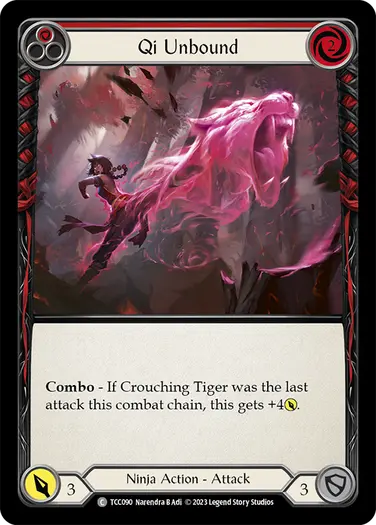One of the most commonly discussed topics of Rules and Policy is card legality. How do you determine whether a card is a legal game piece for use in an official tournament? Today we’re going to talk about some updates to the Tournament Rules and Policy surrounding tournament materials, and dive into some of the nuances when it comes to misprints, alters, proxies, and tokens.
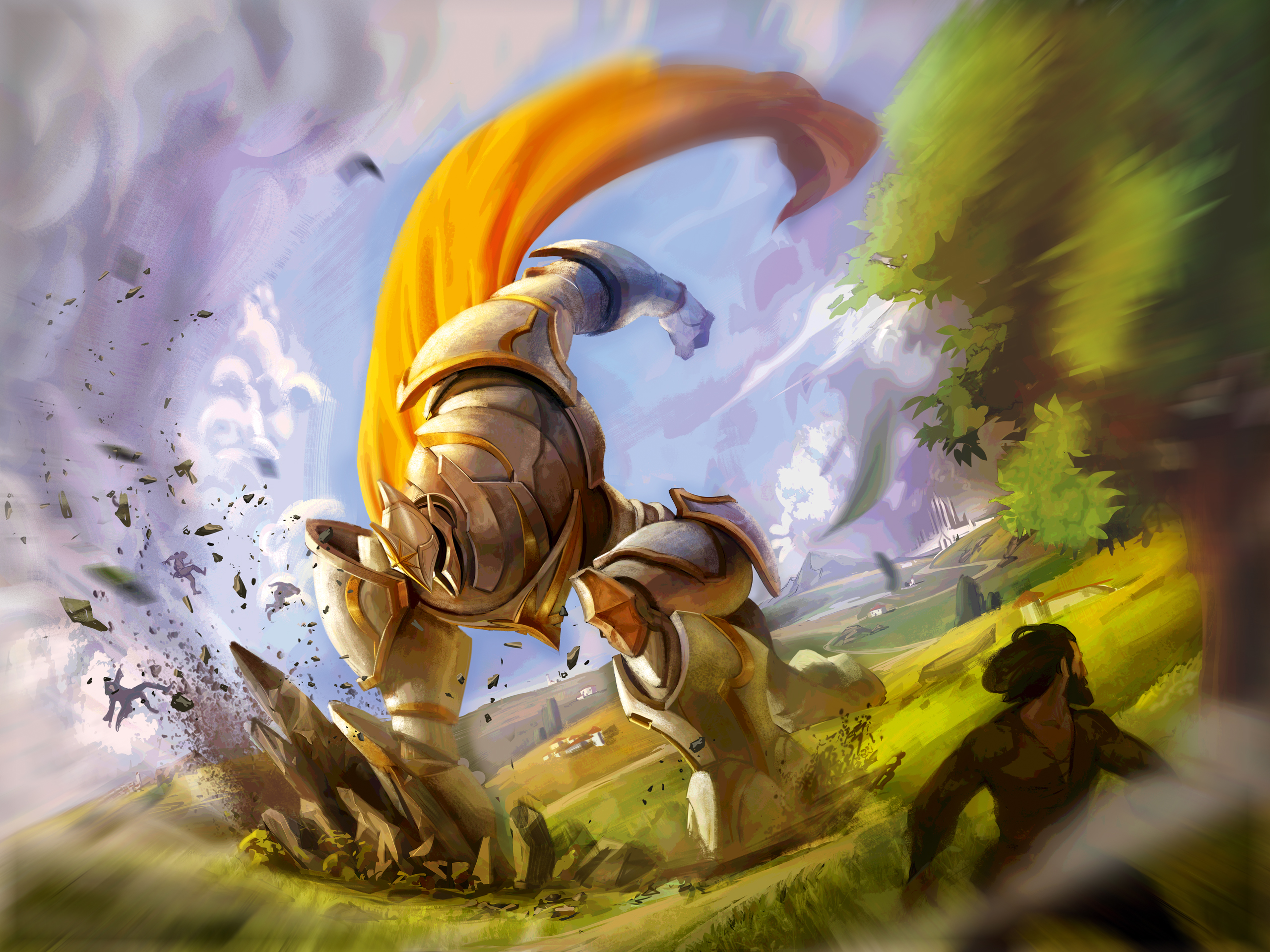
Overview
- Cards need to be easily recognisable
- Cards need to have all their information (with a few exceptions)
- At competitive/professional REL, you must get permission from the Head Judge to use an altered card
- The Head Judge has the final say on the standards for acceptable cards
First and foremost, it’s important to understand the underlying philosophy behind the policy that governs card legality. Our current stance is based on our core philosophy of bringing people together through the common language of playing great games. This is done with two basic ideas:
- Cards should be fit for competitive play. Players (and often judges/spectators) must be able to recognise cards instantly and view their relevant information. This is especially important for bridging communication barriers between players. While there is some leeway, information needs to be conveyed quickly and accurately to ensure a clean gameplay and viewing experience.
- Cards should be official products that were intended for play. As part of the TCG experience, players should benefit from collecting and using cards from official products. To protect this idea, unofficial products and products not intended for play are prohibited from being used at tournaments.
There are some additional caveats that round out the policy, such as prohibiting material that is inappropriate, offensive, or infringes upon intellectual property rights. In addition, cards in your deck (deck-cards) must not be marked, regardless of whether they are altered, misprinted, etc.
It is important to note that this is an incredibly subjective topic, and the examples provided in this article are simply to give a visual reference of the spectrum. However, it is ultimately up to the Head Judge of a tournament to decide, based on the criteria laid out in the Tournament Rules and Policy, whether a misprinted, altered, or token card is legal to play in that tournament.
Official cards
A Flesh and Blood card is considered to be official if it is from a Legend Story Studios product, and is one of the following:
- A single-faced card with the official Flesh and Blood back-face (i.e. most cards)
- A single-faced card with a full-art back-face (e.g. marvel heroes)
- A single-faced card with an official serialized sketch back-face (e.g. DTD art cards)
- A double-faced card (i.e. most flip-cards)
- A double-sided token-rarity card (i.e. most token-rarity cards)
Artist proofs, informational cards, and oversized cards are examples of cards that are not intended for official play. Artist proofs have white-backs and are given to artists to distribute, not through official Legend Story Studios products. Informational cards are typically found in Preconstructed Blitz decks – they have a full hero art on one side and information on the other, but don’t have relevant information required to be a game piece. Oversized cards can be found on the prize wall of large events, and quite obviously do not fit in a standard play area. While these are all great to collect and own, they are not fit-for-purpose as game pieces in official tournaments.
Misprinted cards
Misprinted cards are cards that do not come out the way they were intended, due to a design or printing error.
In general, misprints may be used as long as:
- It is clear what the card is (especially the artwork and the colour strip)
- It does not show the properties of another card
- It is not being used to gain an advantage (e.g. using misleading text or pictures)
If any of the information on a misprinted card is missing or objectively incorrect, the Player has the responsibility to inform their opponent when the card becomes visible, and have that information available for the opponent to refer to.
Acceptable Misprints:
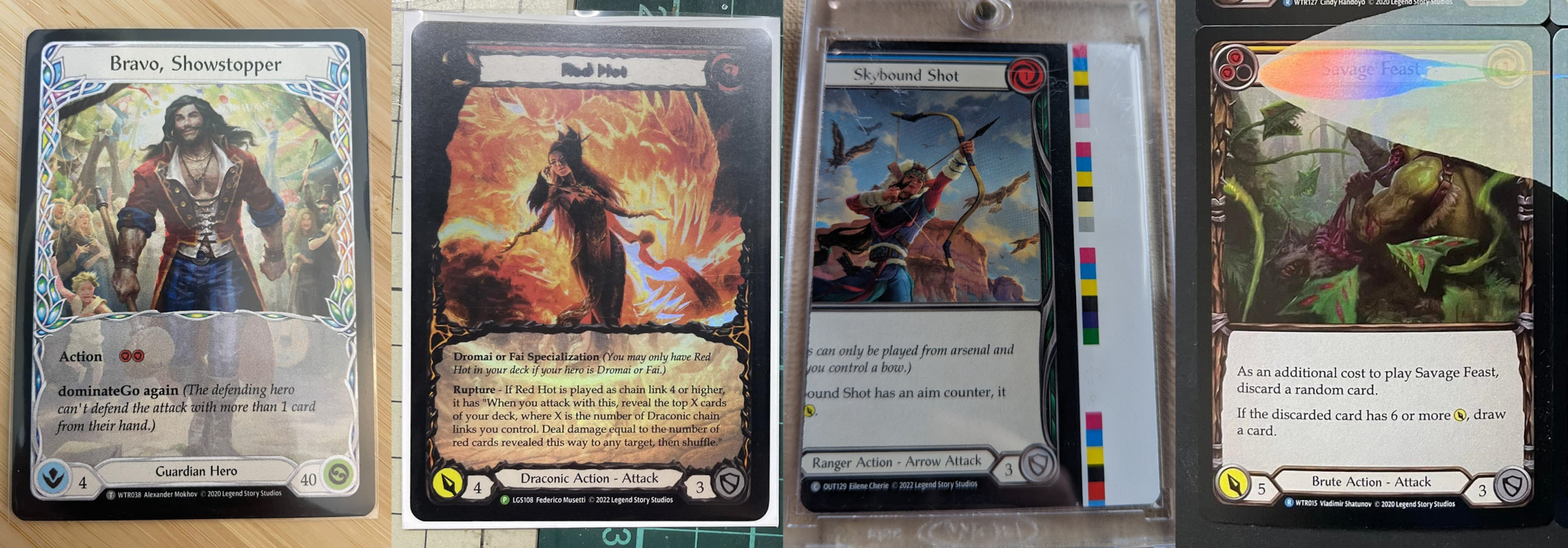
In each of these cases, the artwork (and colour strip) are clearly visible and ensure that the card is immediately recognisable. For any of the missing information (e.g. Skybound Shot) the Player must have that information on hand for their opponent's reference. If the name and/or text of a card is ambiguous or unclear, players may request a judge to give the most up-to-date information on the card.
Unacceptable Misprints:
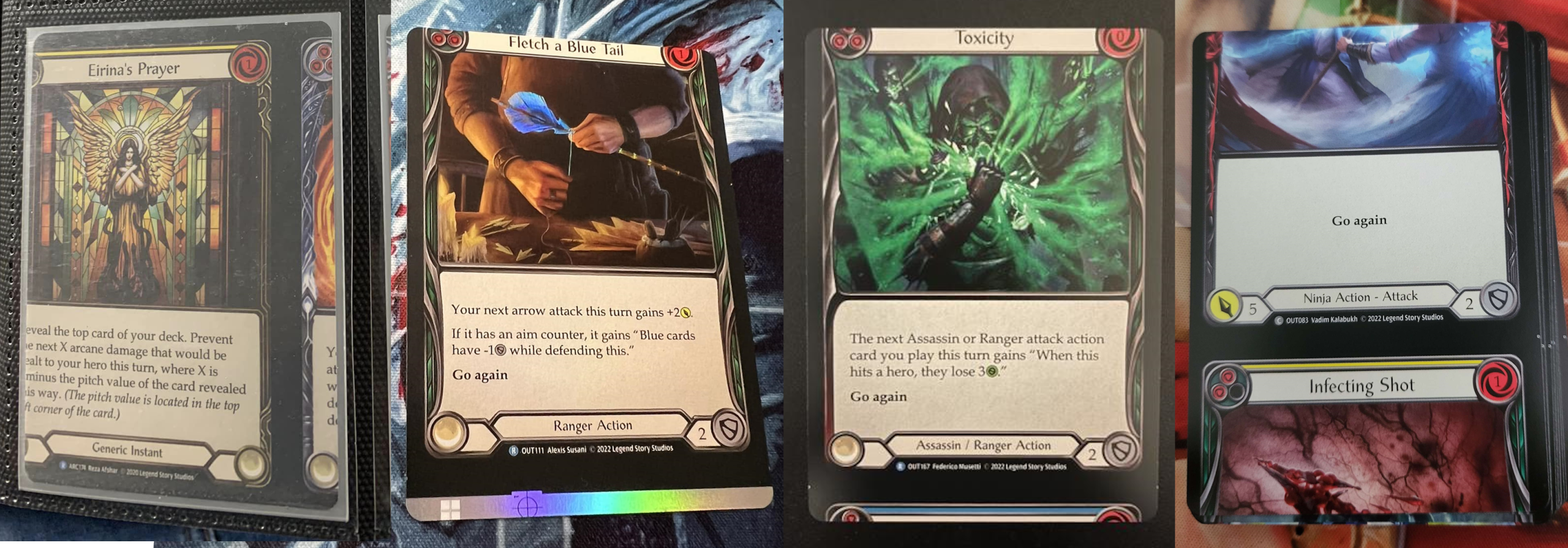
In each of these cases, the misprint either contains the properties of another card (pitch, colour strip, cost, artwork, etc) or is missing crucial information that quickly identifies what the card is (especially the colour strip).
Special mentions:
In cases where the information on a card is objectively incorrect, care needs to be taken about whether the card is legal to use. For example, Arcanic Crackle (blue) in the HP1 Viserai Blitz Deck incorrectly has a printed power of 2 instead of 1, and Qi Unbound in the Ira, Crimson Haze Deck from Round the Table: TCC x LSS should actually have the name Qi Unleashed. Players should be allowed to use cards like these as long as they are not doing so to gain an advantage; and they must present the correct information to their opponent whenever the card becomes visible.
Altered cards
Altered cards are cards that have been intentionally physically altered, mainly for artistic purposes. Alterations include anything that intentionally alters the visuals of the card, such as painting, signing, foiling, collages, and printed inner-sleeves.
While we recognise that alters are a great way for the community to further engage with the beautiful artwork, design, and lore of Flesh and Blood, it is important to ensure that if you’re planning on using it in a tournament, the modifications do not cause the card to be unfit for competitive play.
- It must represent the original, official card used to create the alter (e.g. you must start with a Head Jab (red), if you want to end up with an altered Head Jab (red))
- Its authenticity as an official card must be able to be validated (i.e. you can’t cover up everything)
- The original name, colour strip, and numeric properties (cost, defense, life, pitch, power, intellect, etc.) must be visible
At competitive and professional REL, a player must receive approval from the Head Judge before using an altered card for the tournament. The primary subject(s) of the artwork must not be altered beyond recognition, including drastic changes to the silhouette, colour scheme, and focus of the primary subject(s) in the artwork.
Acceptable Alters:
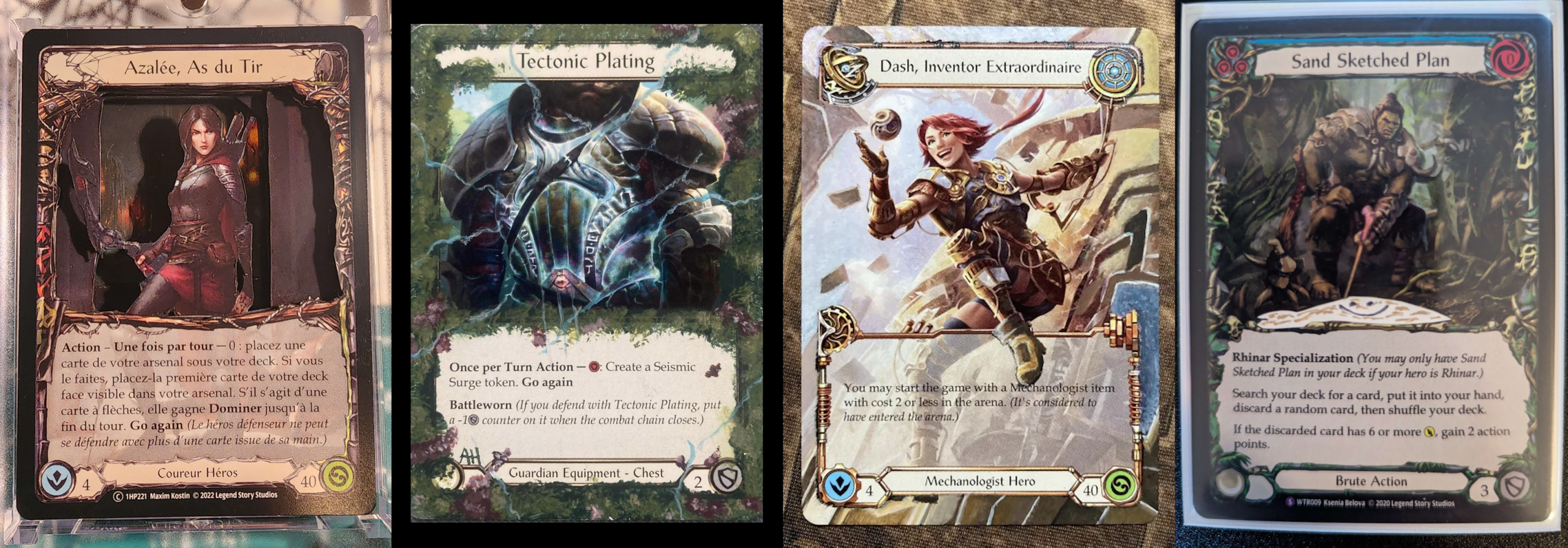
These would generally be acceptable alters. The primary subject of the artwork remains the same and the cards overall are easily recognisable. The key properties of the card are visible and the cards can be validated for their authenticity.
It’s also important to note that these specific alters were created by overpainting or collage. Alters that use the digital assets or intellectual property of Legend Story Studios would not be acceptable as tournament legal.
Unacceptable Alters:
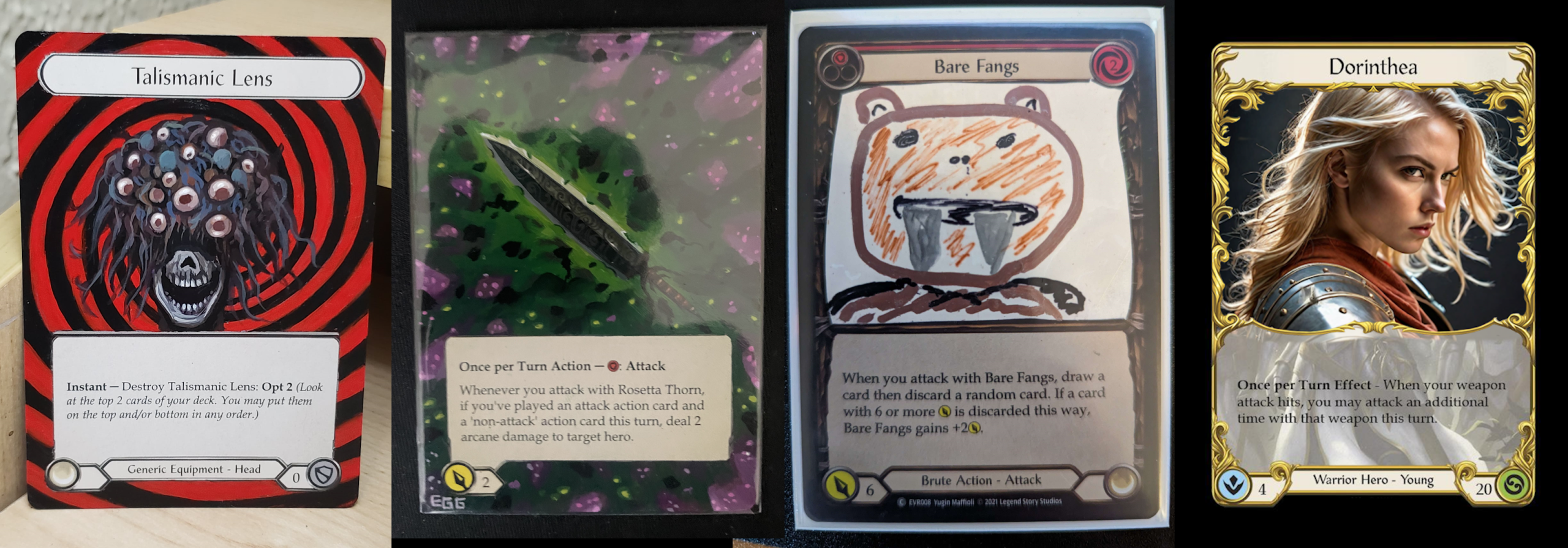
In these cases, the cards have been altered beyond immediate recognition. While these might be fun to collect and play kitchen table games, they are not suitable for tournament play.
Proxy cards
A proxy card (proxy) is a card that is used to represent an official card in a game.
Proxies are not permitted unless officially issued by the Head Judge of the tournament, and only in the following cases:
- A foil card where the foiling is the reason it was identified as a marked card, and there is no non-foil version of the card or it would be unreasonable to expect the player to find a substitute
- A damaged card where the damage is the reason it was identified as a marked card, and the card was opened from limited product with damage, or the damage was caused by the player's opponent or by a tournament official
- A token-rarity card at a limited event where there are insufficient official cards available
- A created card where a player has made a reasonable attempt to supply enough created cards for their game but it is not sufficient for the current game-state
- Printed Ira Welcome Decks at a Learn to Play event
This policy is to protect the two ideas outlined at the beginning of this article. Proxies are only used in the few cases where a player’s participation in a tournament would otherwise be unduly affected and there are no other viable alternatives.
Token cards
Tokens are card-like objects that represent token cards within the game. Official tokens are printed with the "token" type in the typebox of the card. Tokens are not to be confused with token-rarity cards, which do not have the "token" type.
Players have a bit more freedom with tokens. Players do not have to use the official Flesh and Blood tokens, and may create and use unofficial tokens, as long as it is following these criteria:
- It is card-like (rectangular with a height-width ratio of approximately 7:5)
- It is no smaller than half the size of a card and no larger than a card (a card is approximately 88x63mm)
- Any game-related properties are clearly readable
- It can't be confused with another card
While there is some leeway with how tokens are presented, these criteria ensure that players can expect consistency across what tokens may look like, and that it doesn’t adversely affect typical gameplay.

